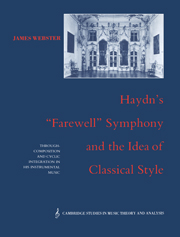 Haydn's 'Farewell' Symphony and the Idea of Classical Style
Haydn's 'Farewell' Symphony and the Idea of Classical Style THE FORM OF THE DOUBLE FINALE
The second cycle of the Farewell Symphony comprises the Presto and the unique Adagio farewell movement, which together make up the double finale. (The rationale for this term has been given in Chapter 1; see also the discussion of eighteenth-century genre patterns in Chapter 6.) It is entirely progressive – not merely in being through-composed and in the “action” of the “farewells,” but also in thematic development and formal and tonal structure. The farewell music has never been analyzed; a brief overview at the beginning of this chapter may therefore be helpful. However, its form can be understood only in conjunction with the Presto: the movement pair is not only run-on, but governed by a single background progression (see Example 3.5 below). The Presto, in many respects a typical “Sturm und Drang” symphonic finale, is in very clear sonata form, except that the recapitulation breaks off at the last minute without attaining closure; this disruption leads to a structural dominant, which does not resolve, but progresses indirectly to A major and the farewell movement (this join is shown in Example 1.4). The latter is in two main parts: a binary movement in A (mm. 1–55), and a compressed recapitulation and conclusion in F-sharp major (mm. 68–107); they are linked by a modulating transition (mm. 55–67), which “recaptures” the unresolved structural dominant from the end of the Presto. (Throughout this discussion I use Landon's measure numbering for the farewell movement; the corresponding numbers in JHW are higher by 150.) Hence the concluding F-sharp-major section provides tonal resolution for the entire double finale.
To save this book to your Kindle, first ensure [email protected] is added to your Approved Personal Document E-mail List under your Personal Document Settings on the Manage Your Content and Devices page of your Amazon account. Then enter the ‘name’ part of your Kindle email address below. Find out more about saving to your Kindle.
Note you can select to save to either the @free.kindle.com or @kindle.com variations. ‘@free.kindle.com’ emails are free but can only be saved to your device when it is connected to wi-fi. ‘@kindle.com’ emails can be delivered even when you are not connected to wi-fi, but note that service fees apply.
Find out more about the Kindle Personal Document Service.
To save content items to your account, please confirm that you agree to abide by our usage policies. If this is the first time you use this feature, you will be asked to authorise Cambridge Core to connect with your account. Find out more about saving content to Dropbox.
To save content items to your account, please confirm that you agree to abide by our usage policies. If this is the first time you use this feature, you will be asked to authorise Cambridge Core to connect with your account. Find out more about saving content to Google Drive.